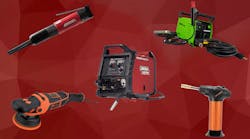Spot welders are a vital part of today’s body shop arsenal, and it pays to learn the fundamentals of how they operate. When you’re armed with the basics, you’ll know what to look for when shopping for a welder, and you’ll be ready to start learning how to use one if you’re a technician. Here’s what you need to know about this kind of welder:
Spot welding defined
At the most basic level, spot welding fuses together two pieces of metal that are overlaid on each other (not butted up together). The welder has a set of pincer-like electrodes that clamp down on the two pieces of metal, holding them together. The resistance and pressure at this point of contact causes the metal to heat up, become molten and then fuse together.
This method of welding is different from another common type of welding called brazing. While spot welding doesn’t add anything in the welding process, brazing adds another material (via a wire feed or rod) to join two pieces of metal. When the spot weld is finished, you’ll just see a round dot where the pieces are joined together.
How spot welders are used
Spot welding is used in a variety of fields, and it’s the most common type of weld in today’s vehicles. Vehicle manufacturers use spot welding to hold the various pieces of the car or truck together.
Spot welding is also common in auto body repair shops. When a piece of the vehicle’s frame or body is damaged, technicians sometimes need to remove the bent or smashed portion and replace it entirely. When they add in the new piece, they’ll use an auto body spot welder to secure it in place. Since this is exactly how they build the car in the factory, repairs done in this way (if done right) will be just as good as new.
What elements affect the weld?
There are several things that factor into a spot weld, including:
- Resistance. The metal’s resistance to the flow of electricity is what heats up the two sheets of metal.
- The type of metal being repaired. Different metals have different resistance levels, so this will affect the welding process.
- Amperage. The strength of the current also affects the welding outcome. If amperage is too high or too low, you could see spattering or low-quality welds.
- Pressure. The pressure of the pincers also plays into a weld. The pincers hold the two pieces of metal together while they’re heating up, and then keep them together for a short time, so that as the metal cools and hardens, the pieces remain fused. Timing is important here.
- Thickness of metal. Along with the type of metal you’re working with, the thickness of the metal also affects the weld. It takes more to heat up thicker metal, and thinner metal could burn through if welded improperly.
With so many factors in play, there is a lot of room for operator error, so it’s important to understand the materials you’re working with and how to adjust the equipment you’re using. Or, you can use automated tools to do the heavy lifting. For example, MULTISPOT MI-100control T has TrueAutoMode, which means it will automatically sense the resistance of the metal, and then provide the exact amount of power and pressure to make a perfect weld every time. Automation like this reduces the chance of costly mistakes and makes technician’s jobs a lot easier.
Auto body spot welders are important tools in repair shops, and understanding how they work and how to use them is important for both techs and shop managers. The more you know, the better-equipped you’ll be to use them.
Source: Collisionology - Chief Automotive Technologies


